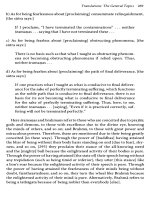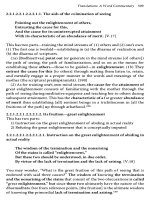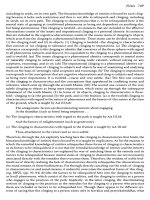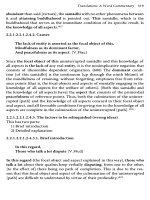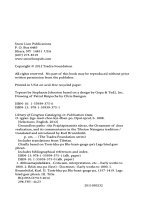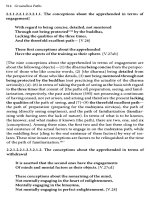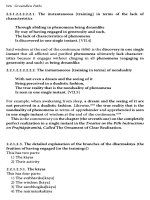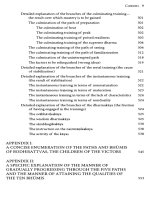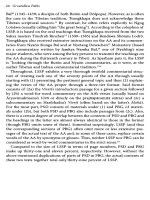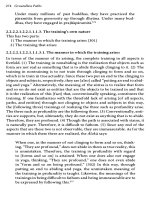Groundless paths the prajnaparamita sutras, the o ( (52)
Bạn đang xem bản rút gọn của tài liệu. Xem và tải ngay bản đầy đủ của tài liệu tại đây (91.27 KB, 5 trang )
Translations: The General Topics
269
b) As for being fearlessness about [proclaiming] consum m ate relinquishm ent,
[the sutra says:]
If I proclaim, “I have term inated the contam in ation s” . . . neither
sram anas . . . saying that I have not term in ated these . . .
c) As for being fearless about [proclaiming] obstructing p henom ena, [the
su tra says:]
There is no basis such as that what I taught as obstructing p h e n o m
ena not becom ing obstructing p h e n o m en a if relied upon. Thus,
n e ith e r s r a m a n a s . . .
d) As for being fearless about [proclaiming] the path of final deliverance, [the
sutra says:]
If one practices w hat I ta u g h t as w hat is conducive to final deliver
ance f or the sake o f perfectly term inating suffering, which functions
as the noble path that is conducive to final deliverance, there is no
basis for its not becom ing w hat is conducive to final deliverance
for the sake o f perfectly term inating suffering. Thus, here, to me,
neither sram anas . . . [saying], “Even if it is practiced correctly, suf
fering will not be term inated perfectly.”
Here sramanas and brahm ans refer to those who are conceited due to prajna;
gods and dem ons, to those w ith excellence due to the divine eye, know ing
the m inds o f others, and so on; and Brahma, to those with great pow er and
m iraculous powers. Therefore, these are m ention ed due to their being greatly
conceited [in these ways]. T hrough the pow er o f [buddhas] having attained
the bliss of being w ithout their body hairs standing on end [due to fear], shy
ness, and so on, {295} they proclaim their stance o f the all-know ing steed
and the [mighty] bull because the enlightened activity o f their bodies is pure.
T h roug h the pow er o f having attained [the state of] their speech being w ithou t
any trepidation (such as being tim id or inferior), they u tter [this stance] like
a lion’s roar because the enlightened activity o f their speech is pure. T h ro ugh
the pow er o f having attained the fearlessness o f their m inds being w ithout
doubt, faintheartedness, an d so on, they tu rn the wheel like Brahma because
the enlightened activity o f their m ind is pure. Alternatively, B rahm a refers to
being a tathagata because o f being nobler than everybody [else].
270 Groundless Paths
3) The third [set] consists o f the four aspects of the discrim inating aw are
nesses. W hat are they?
a) The discrim inating awareness o f dharm as is to engage in [the objects that
consist of] the twelve branches o f [a b u d d h a’s] speech or the objects that co n
sist of th e synonym s th a t are m eans o f expression (such as “the one with
white light” and “the one with a rabbit”)571 w ithout any attachm ent of relish
ing them and any obstruction of cognitive obscurations.
b) [The discrim inating aw areness of] m eanings [is to engage,] as before, in the
objects that consist of w hat is expressed by the twelve branches or the specific
and general characteristics o f phenom ena.
c) [The discrim inating awareness of] semantics [is to engage,] as before, in the
objects that consist o f the languages w ithin the six [realms of] beings or the
languages of each country.
d) [The discriminating awareness of] self-confidence [is to engage,] as
before and in order to teach others, in the objects that consist o f the m a n i
fest triad [(a)—(c)] of dharm as and so on or the subdivisions of the natures
and the aspects of phenom ena, such as their existing substantially or existing
imputedly.
Since these four [awarenesses] are w ithout attachm ent and obstruction with
regard to said four [sets of] objects, they are discrim inating awarenesses. {296}
4) T he eighteen dharm as o f th e buddh a qualities that are unique com pared to
others are (a) th e six that consist of conduct, (b) th e six that consist of realiza
tion, (c) the three that consist of enlightened activity, and (d) the three that
consist of wisdom.
a) The six flaws that will be explained [in the following] are possible for arhats
o f the hlnayana, but tathagatas [lack them. (1) They lack] being harm ed by
fierce elephants, cattle, dogs, and so on, and lack any mistakenness such as
crushing black snakes un d er their feet. Therefore, their physical actions are
pure. (2) They lack chatter, such as spoiling the path and thus uttering chat
tering sounds and, u n d er the sway of latent tendencies, guffawing like a horse.
Therefore, their verbal actions are pure. (3) T hey lack any deterioration of
mindfulness in term s o f failing to do som ething by virtue of forgetfulness a n d
it th e n being too late [to do it]. (4) At all tim es, they lack [a m ind th a t is] not
settled in meditative equipoise, no m atte r w hether th ey rest or do no t rest in
meditative absorption. (5) They lack discriminations in term s o f [samsaric]
existence and n irv an a being different by w ay of clinging to th em as being dis
co rd an t or concordant. (6) T hey lack the indifference o f forsaking the welfare
o f sentient beings thro ugh not exam inining [whether] the tim e for guiding
them [is right or not] and so on. These four aspects represent the purity of
their m ental actions. Thus, [these] are the six [aspects of unique conduct].572
Translations: The General Topics
271
b) [As for the six aspects o f unique realization,] (7) tathàgatas lack any dete
rioration o f their striving because they always prom ote the welfare o f sentient
beings and incessantly wish for the dharm as such as great love and com pas
sion. {297} (8) T hey lack an y deterioration o f vigor in th a t they, for the sake of
each single sentient being, go to the places o f [all] b u d d h a realm s th a t exceed
[the n u m b er o f the grains of] sand in the River Gangâ. (9) They lack any dete
rio ration o f m indfulness in th a t they, after having becom e buddhas, place the
m ental behaviors o f all beings in the three times, the means to guide them , and
so on onto the path o f m indfulness and therefore do not have to th in k about
these [things] later. (10) They lack any deterioration o f the sam adhi o f rest
ing in m editative equipoise in the suchness o f all phenom ena. (11) They lack
any deterioration of prajna because their knowledge o f the m ental behaviors
o f sentient beings an d teaching the d h arm a is inexhaustible. (12) They lack
any deterioration o f their inexhaustible liberation w ithin their prom oting the
welfare o f sentient beings for as long as samsara exists. Thus, [these] are the
six aspects [of unique realization]. A m ong these six, striving is the support;
the m iddle four, the faculties; a nd the last one, the fruition. For those in the
hlnayana, there is no deterioration o f these six once they have been attained,
but there is deterioration w hen they have not been attained [fully]. However,
for tathàgatas, there is no [deterioration] in either [case].
c) [As fo r the three aspects o f unique enlightened activity,] the enlightened
activities o f [a b u d d h a ’s] body guiding sentient beings th ro u g h radiating light,
walking, opening his eyes, and so on; the enlightened activities o f his speech
instructing sentient beings in accordance with their thinking and their laten
cies; and the enlightened activities o f his m in d having relinquished all latent
tendencies w ithout exception an d being endow ed with great love {298} arise
from the cause o f w isdom having arisen before them . Therefore, these are the
three aspects o f [said enlightened activities both] being preceded by wisdom
and, since they flow together with wisdom, following w isdom.
d) The th ree aspects o f [unique] w isdom are th at [this w isdom ], th ro u g h the
mere wish [to know them ], knows all knowable objects in the three times
th at occur in the past, the future, and the present. By virtue o f that, it is not
attached to th e m and, by virtue o f know ing everything, it is not obstructed
[with regard to th em either].
2.2.2.2.1.2.2.1.1.1.1.2.3.2.3.2. Their nature
It is only by virtue o f the differences o f those to be guided that the buddhas
who appear teach three yànas or a single one, bu t it is not possible fo r them to
not teach suchness. Therefore, the suchness that is explained by all buddhas is
the nirvana o f being pure o f all stains w ithout exception.
272 Groundless Paths
2.2.2.2.1.2.2.L1.1.1.2.3.2.3.3. W hose [qualities] they are
To have gained mastery over all conditioned and unconditioned p h enom ena
is throu gh the pow er of w h a t is self-arisen, th at is, self-arisen wisdom. [In
general,] what is self-arisen is twofold—the dharm ad h atu a n d th e wisdom o f
som eone in their last existence realizing all knowable objects. In term s o f the
first one, this corresponds to what the Gandavyuhasutra [says]:
T hough some w orldly realms,
Inconceivable [in their num ber], are burned,
Space will not be destroyed.
Self-arisen w isdom is just like that.
As for the second one, through bodhisattvas having familiarized with the
instructions of spiritual friends for a long time, w ithout depending on a m as
ter, [their final w isdom ] is self-arisen. {299} As it is said:
Having arrived, I am a buddha.
I have nobody as a master.
Since the first one o f these [two kinds o f w hat is self-arisen] is the suchness
that is explained by all buddhas, it is the second one that is to be taken here [as
that which possesses th e above qualities].573
2.2.2.2.1.2.2.1.1.I.I.2.3.2.3.4. F o r w hat aim they are
[The aim is represented by] the aspect that is b u d d h a h o o d —the perfect real
ization o f all aspects o f suchness and variety.
Thus, the [last] three [am ong these thirty-nine aspects of the knowledge
o f all aspects are suchness, w hat is self-arisen, and buddhahood]. W h en the
wisdom of the knowledge of all aspects is attained through having focused
on suchness, it is by v irtue o f its being endow ed w ith the pow er o f m astering
all entities [that it is presented] as w hat is self-arisen. By v irtue of its know ing
all kinds o f knowable objects w ithout m ixing them , it is presented as b u d
dhahood. A part from that, there is no difference. In this way, suchness is the
nature o f the thirty-six qualities [before it]. W hat is self-arisen refers to h av
ing gained m astery over the collection of these qualities, or to the persons to
which [they belong]. The last [aspect] refers to the aim for which these [quali
ties] are, [namely, bu ddhahood]. It is in this way that [these] are the [last]
three [aspects o f the knowledge o f all aspects].574
Translations: The General Topics
273
2.2.2.2.1.2.2.L1.1.2. The persons who train
This
1)
2)
3)
4)
has four parts:
[The vessels who]
[The vessels who]
[The vessels who]
[The vessels who]
listen [to prajňápáram itá]
take it [into their minds]
retain it
m entally engage in it properly
2.2.2.2.1.2.2.1.1.1.2.1. The vessels who listen [to prajňápáramitá]
[According to the sutras, those w ho are able to listen to prajňápáram itá] are
endow ed w ith three distinctive features:
The sons o f good family or the daughters o f good family in whose
ears this p rajň áp áram itá resounds have perform ed their duties for
past victors. {300} Those in whose ears it resounds have produced
roots o f v irtu e w ith regard to the tathágatas . . . were m en to re d by
spiritual friends.575
2.2.2.2.1.2.2.1.1.1.2.2. The vessels who take it [into their minds]
Those w ho ren d ered th eir services to m any b u d d h a s rep resent the vessels who
take the w ords [of prajňápáram itá] to m ind. [The sutras say:]
H ow m uch m ore so for those w ho . . . having ta k e n it [into their
m inds], seized it, read it, understood it, and m entally engaged in
it, seriously engage in prajňápáram itá as suchness. They rendered
their services to m any buddhas.
2.2.2.2.1.2.2.1.1.1.2.3. The vessels who retain it
Those who, after having rendered their services to the buddhas, asked them
questions about all the m eanings about w hich they have doubts represent the
vessels w ho retain the m eanings [of the w ords o f prajňápáram itá. The sutras
say:]
T hey asked the past tathágatas, the arhats, the com pletely perfect
buddhas, questions, attended them , and paid their services.
2.2.2.2.1.2.2.1.1.1.2.4. The vessels who mentally engage in it properly
Those who attended budd has and so on and thus engaged in the páram itás
(such as generosity) represent the vessels w ho m entally engage in the charac
teristics [of prajňápáram itá] in a p roper m anner. [The sutras say:]
